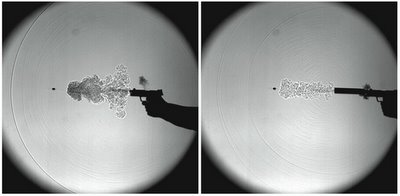Blast Scapes

Some pioneering high-speed videography here shows the amazing spectral typographies of the shockwave, whose role in military application is well explained in this article from the American Scientist Magazine. Illuminated is a fascinating history of shockwave cinematography and it's usefulness in understanding blast effects on engineering, medicinal research, materials processing, forensics, and implications of security. As Gary Settles, head of The Penn State Gas Dynamics Laboratory, writes in the opening of his article: "Recent attacks by terrorists using improvised explosive devices have reinforced the importance of understanding blasts, explosions and the resulting shock waves. These waves can be powerfully damaging in their own right, but in addition, studying them can help to quantify their originating explosions and can provide insight into how buildings and airplanes can be hardened to resist damage resulting from such blasts."

"If you are unlucky enough to be shot at but lucky enough to be missed, sometimes you hear instead the sound of the bullet itself."




"Inertia keeps supersonic bullets moving at high speed, while the muzzle blast rapidly decays in strength like the spherical shock wave from an explosion. So the bullet inexorably pulls ahead of the decaying muzzle blast, trailing oblique shock waves."


[All images: The Penn State Gas Dynamics Laboratory, High-speed Imaging of Shock Waves, Explosions and Gunshots, American Scientist Magazine, 2006]
"These shock waves produce the sensation of a sharp 'crack' as the bullet passes, followed later by the 'bang' of the muzzle blast. This sequence varies with timing and the hearer's position with respect to the bullet's path, making it very difficult to determine the direction of gunfire from its perceived sounds." - Gary Settles
If only I could somewhow surf the shockwave of a slowed down gun shot.
I imagine a nanoscale architecture fitted on the backs of my Entomomechanophilic Army, invisible prefab shelters carried like snail shells, both designed to protect them from such a blast, but also, to bring forth a payload of seeds delivered from inside when these blast bugs are made to pop from their shells during flight (the methods of such might resemble something akin to the Animal Vegatable Video). Little war-time humanitarians like these crop-dusting wasps that have been designed specifically to regarden blast-intensive environments (battlefields and bombed sites), so the radial effects can push/spread them across the landscape, over and over again. Air-plowing in a blaze of glory while playing another Olympic round of Garden Wars with your Tree Bombs or extra munitions left over from the Iceland Soil-Bombing Campaign.
Via: collision detection and American Scientist Magazine
UPDATE[01.05.06]: Also see this post on gravestmor, 'Atomic Rapatronic' with amazing stroboscopic photos by Harold Edgerton. And, if you can make it, check out the exhibit at the MIT Museum: 'Flashes of Inspiration: The Work of Harold Edgerton.' Watch archived video of Edgerton here at the MIT Edgerton Center. (Thanks to Heather Ring for those links!)







0 Comments:
Post a Comment
<< Home